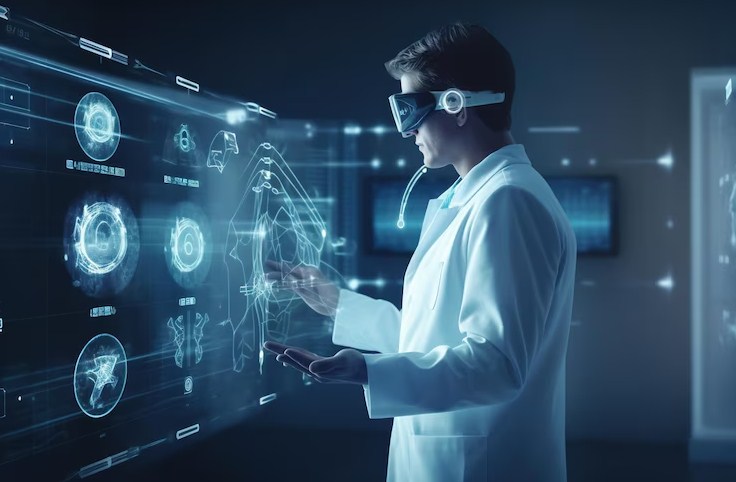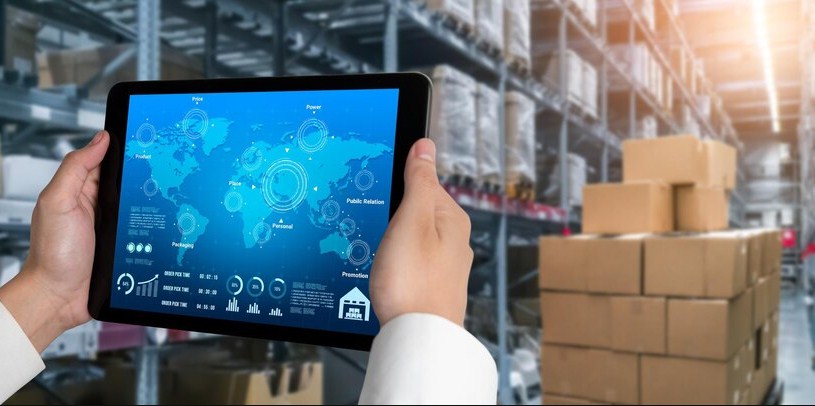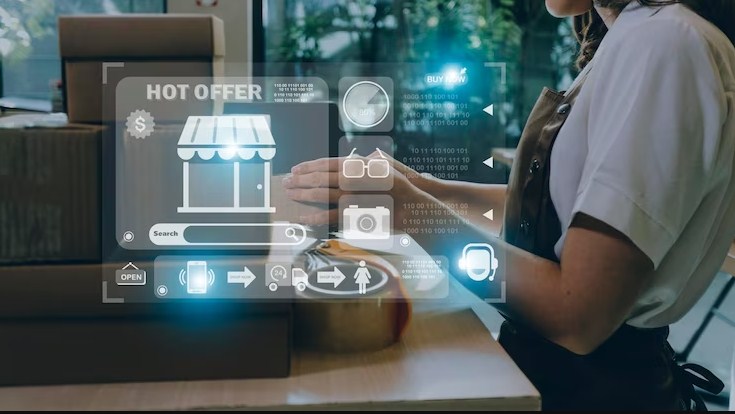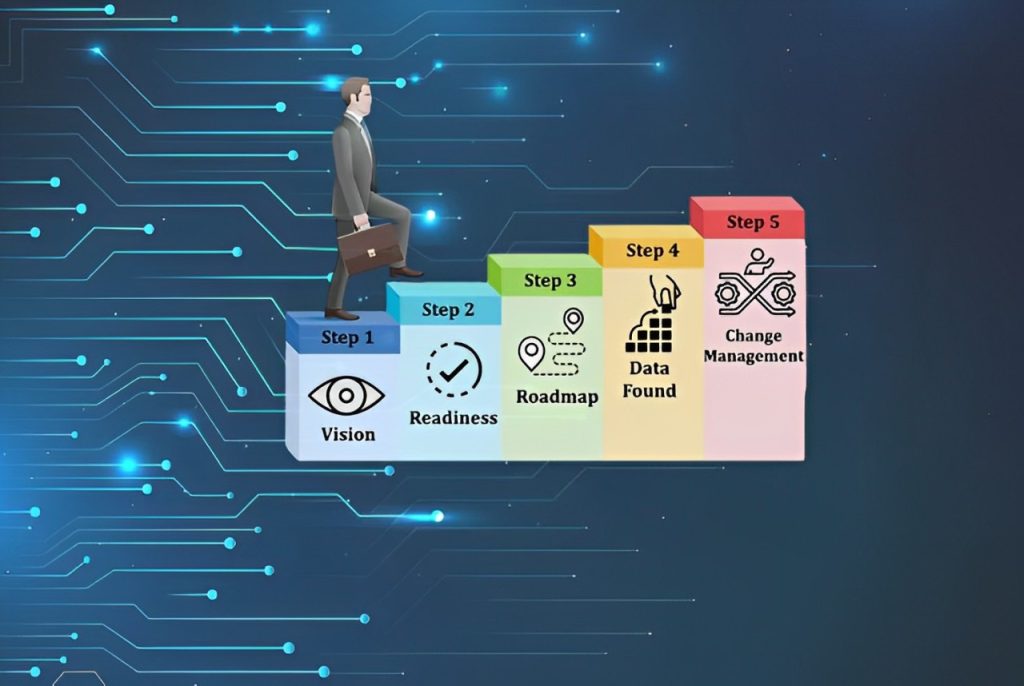Digital Transformation in Different Industries: Future Trends & Strategies
The world is changing fast, and digital technology is leading this shift in many fields. Businesses that don’t keep up with digital tools might fall behind others who are quick to change and innovate.
Industries That Can Benefit from Digital Transformation Services are Healthcare, Finance, Education, Transportation, and logistics.
Let’s look at some important areas that need to go digital, the problems they face, and what good things could happen for those who make the change successfully and look at how companies use digital transformation.
Healthcare

The healthcare field has been pretty slow to use digital tech, mainly because they worry about keeping patient info safe, following rules, and fitting new systems into old ones.
But, when COVID-19 came around, it pushed healthcare to quickly start using digital options like online doctor visits and watching patients from afar because they had to.
In the healthcare industry, real-world examples of digital transformation include the adoption of electronic health records and telemedicine platforms.
Problems and chances for better things
- A big problem with going digital in healthcare is making sure patient information stays private and secure.
- Healthcare places deal with very private info, and any mistake with it could cause big legal and ethical issues.
- Also, they need to make sure that the digital tools are easy for people of all ages and tech skills to use.
- On the bright side, going digital can make healthcare better by making things run smoother, cutting costs, and improving care.
- Digital health records (EHRs) can help doctors work well together, cut down on mistakes, and make paperwork easier.
- Online doctor visits can reach people living far away or in places without enough doctors while keeping an eye on patients from a distance could help stop health problems before they get worse.
Adding artificial intelligence (AI) and machine learning (ML) could also bring big changes by spotting diseases early on, creating personal treatment plans, and coming up with new medicines.
By looking at lots of patient data, AI programs can find trends and insights that humans might not see.
Education
How online learning platforms are growing
When COVID-19 hit hard on regular schools, there was a big jump in the use of e-learning platforms.
Websites like Coursera, edX, and Udemy became very popular because they offer lots of courses anyone can take from anywhere.
These platforms didn’t just help when schools were closed but also opened doors for everyone to keep learning new things throughout their life.
Now, both students and professionals can easily get their hands on top-notch learning materials whenever they want. This change makes education fairer by removing the limits of location.
Tech Makes Learning Personal
The way we learn is getting a big upgrade, not just through online classes. Cool new tech tools help make lessons perfect for what each student needs.
If you’re doing great or need a bit of help, these smart systems adjust what you learn and how fast you go. Plus, it makes sticking with it and understanding stuff better.
And guess what? Learning gets even cooler with things like AR and VR.
Across various sectors, including education and finance, digital transformation by industry is revolutionizing traditional processes and driving innovation.
These tech wonders turn tough ideas into something you can see and touch, making everything from studying cells to cities a blast.
Imagine being a doctor-to-be practising surgeries without stepping into an OR or an aspiring architect exploring buildings in 3D.
Financial Considerations
How Tech is Changing Banks
Fintech startups are shaking up old-school banking big time, using tech to serve up quicker, easier, and sometimes cheaper ways to manage money.
Think about doing all your banking on your phone or sending cash to friends without cash or checks.
Banks are racing to keep up because everyone now wants their financial dealings smooth and fast, right from their phones.
Blockchain’s Big Promise
You’ve probably heard of Bitcoin, but solana rpc blockchain network, the magic behind it, is starting to jazz up the finance world in other ways too.
It’s all about making transactions secure yet clear as day, cutting out middlemen costs, and mistakes.
Imagine sending money across the globe or managing properties with fewer headaches!
Securing Finances in the Digital World
As banks go digital, staying safe online is more important than ever. The last thing anyone wants is hackers getting into their accounts.
That’s why banks are beefing up security with stuff like extra password checks and scrambling data so that bad guys can’t read it if they do sneak in.
Companies need to be tough on who can get into their systems, keep their systems fresh and safe, and make sure all employees are smart about online safety.
Many companies turn to legal services for digital financial security to ensure compliance with evolving regulations and protect against cyber threats.
As more people use online banking and money services, everyone must know how to stay safe and make smart choices online.
Transportation and Logistics
Moving Goods Gets Smarter
The business of moving and storing things is getting a big tech update.
Companies are now using robots and self-driving trucks, along with flying drones to deliver packages. This tech makeover makes everything run smoother and faster.
Businesses may save money, make fewer mistakes, and gain a better knowledge of their supply chains from beginning to finish by assigning tedious or complex activities to robots.
This helps them plan better and keep customers happy.
But, getting all these high-tech helpers isn’t simple.
It is initially expensive, may result in fewer jobs, and requires extremely high security to ensure that no one hacks into the system.
Future of Autonomous Vehicles
Cars that don’t need a person to drive them are starting to show up. They could make getting around safer and less crowded on the roads.
Plus, they might help people who can’t drive find easier ways to travel.
But, there’s a lot we have to figure out first – like how to pay for road improvements, keep the cars safe from cyber tricks, and decide who’s at fault if something goes wrong.
Keeping track of trucks
In the delivery business, knowing where everything is in real-time helps save gas, keeps trucks running smoothly, and makes customers happy.
New tech lets companies see how drivers are doing and find the best routes,
Also, thanks to the internet, companies can work together better than ever before which means less waiting for repairs and more life out of every vehicle.
Boosting Efficiency Strategically
The energy world is changing fast so we can use our resources better. This includes new ways of managing power that help us save energy when we need it.
Smart grids mix new digital tech with old electric systems, letting us watch and control energy use in real-time.
This means we can see when and where energy is used most, cut down on waste, and make it easier to use clean energy.
Plus, things like smart meters let people manage how much electricity they’re using, helping them save money and energy.
But setting up these smart systems isn’t easy. It costs a lot of money, involves combining different tech smoothly, and requires strong protection against cyber-attacks.
Digital Ways to Connect with Customers
As the power world changes, companies are finding new ways to talk to customers online.
Apps, websites, and social media help share updates about bills or give tips for using less power.
These tools make customers happier by letting them know what’s happening and making it easier to work together with their power company. Companies use information from these digital tools to create special deals or advice that can help people use less energy.
Keeping Up with Rules Using Digital Tools
The world of energy has lots of rules about keeping things safe, protecting the environment, and making sure prices are fair.
Digital tools can help make following these rules easier by collecting accurate info easily and making reports quicker.
By storing all their data on cloud platforms, companies can safely share information needed for regular checks while also keeping an eye on everything to ensure they’re doing things right.
Retail and eCommerce
Omnichannel Shopping Experience
A big part of these changes is about giving shoppers a smooth experience, no matter how they choose to shop – in person, on the web, with mobile apps, or through social media.
Everything is connected to make shopping easy and fun for everyone.
Stores are now using cool tech like mobile apps, chatbots, and even virtual reality.
For example, you might use an app from a store to look at products, read what others think, and buy something straight from your phone.
Or you could see how clothes fit without trying them on or imagine how a new couch would look in your living room.
Data-Driven Personalization
Stores have lots of info about what we buy and like. They use this data to make shopping feel special for each person.
By understanding what you’ve looked at or bought before, they can suggest other things you might like or give you deals that matter to you.
This personalized touch makes shopping better for customers, drives them through the ecommerce funnels, and helps stores sell.
It also helps stores plan better by guessing what will be popular in the future so they can keep the right items in stock.
Supply Chain Optimization
Digital tools are making it easier for stores to keep track of their stuff.
With advanced technologies, they can see exactly where each item is at any time. This helps avoid running out of products or having too much stock.
Stores are also using blockchains to make sure their products are real and ethically made by tracking every step from creation to sale.
Automation and Workforce Transformation
Robots and computer systems are starting to do some jobs in stores like checking people out or keeping track of inventory. Automation is transforming the workforce, and digital menu boards are key, streamlining operations and enhancing customer experiences while reducing manual tasks.
These changes mean workers need to learn new skills related to tech and digital marketing.
But this also means staff needs new training so they can work well with the new technology and keep making customers happy.
Conclusion
It’s clear that today’s world moves quickly, and for businesses in all areas, like healthcare and shops, it’s super important to use digital transformation consulting services well.
This helps them stay ahead of the game and listen to what people need.
Yes, there might be some hurdles along the way, like keeping information safe and teaching teams new skills.
But if companies plan smartly, think creatively, and always put their customers first, they can do well in this tech-savvy world.
Thinking about making things better for you every day or at work, which digital tools or gadgets do you believe would be super helpful? Let us know in the comments below!
FAQs
1) How long has the digital transformation been happening in the industry?
Digital transformation is a big idea that’s been getting more and more popular across different businesses, showing us just how important it is to always be coming up with new ideas.
2) How can companies succeed in going digital?
For a successful digital shift, having a clear plan that matches what the company wants to achieve is important.
It’s also crucial to get everybody involved on board, encourage creative thinking, hire skilled digital workers, and keep an eye on new techs and trends in your industry.
Teaming up with tech firms, research groups, and start-ups can offer extra know-how and innovative solutions.
3) How important is the customer experience in going digital?
Customer experience is very important when shifting digitally.
With online tools and platforms, customer interactions can be personalized, making services quick and easy to use.
This leads to customers feeling happier, sticking around longer, and supporting business growth.
It’s vital to understand what customers want and use data analysis for deeper insights into their preferences.
4) What should be done about data safety during a digital shift?
Keeping data safe is a top priority during a digital makeover.
Companies should have strong security steps like encrypting information, making sure several checks are in place before access is granted, and carrying out regular security checks.
Following laws on privacy, respecting data protection rules throughout the company, and investing in advanced security systems and employee training are also key steps.







